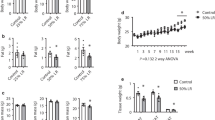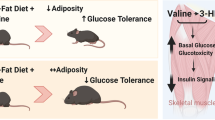Abstract
There has been a growing interest in controlling body weight by increasing dietary levels of leucine recently. By contrast, we have focused on studying the effect of deficiency of branched-chain amino acids (BCAAs) leucine on lipid metabolism. We previously have shown that mice fed a leucine-deficient diet for 7 days exhibit significant changes in lipid metabolism as demonstrated by suppressed lipogenesis in the liver and increased fat mobilization in white adipose tissue, the latter of which was found to be caused by increased lipolysis in WAT and uncoupling protein 1 expression in brown adipose tissue. The goal of our current study is to investigate whether the above effects of leucine deficiency can be generalized to the deficiency of other BCAAs including valine and isoleucine. In our current study, we show that valine or isoleucine deficiency has similar effects on reducing fat mass to leucine deprivation, in a similar manner as those observed during leucine deprivation.





Similar content being viewed by others
References
Anthony TG, McDaniel BJ, Byerley RL, McGrath BC, Cavener DR, McNurlan MA, Wek RC (2004) Preservation of liver protein synthesis during dietary leucine deprivation occurs at the expense of skeletal muscle mass in mice deleted for eIF2 kinase GCN2. J Biol Chem 279(35):36553–36561
Beaudry JL, McClelland GB (2010) Thermogenesis in CD-1 mice after combined chronic hypoxia and cold acclimation. Comp Biochem Physiol 157(3):301–309
Canepa A, Perfumo F, Carrea A, Menoni S, Trivelli A, Delucchi P, Gusmano R (1996) Nutritional status in children receiving chronic peritoneal dialysis. Perit Dial Int 16(Suppl 1):S526–S531
Challet E, Le Maho Y, Malan A (1995) Locomotor activity and utilization of energy reserves during fasting after ventromedial hypothalamic lesions. Physiol Behav 58(2):257–264
Cheng Y, Meng Q, Wang C, Li H, Huang Z, Chen S, Xiao F, Guo F (2010) Leucine deprivation decreases fat mass by stimulation of lipolysis in white adipose tissue and upregulation of uncoupling protein 1 (UCP1) in brown adipose tissue. Diabetes 59(1):17–25
Cochet N, Meister R, Florant GL, Barre H (1999) Regional variation of white adipocyte lipolysis during the annual cycle of the alpine marmot. Comp Biochem Physiol 123(3):225–232
Cota D, Proulx K, Smith KA, Kozma SC, Thomas G, Woods SC, Seeley RJ (2006) Hypothalamic mTOR signaling regulates food intake. Science 312(5775):927–930
Doi M, Yamaoka I, Nakayama M, Mochizuki S, Sugahara K, Yoshizawa F (2005) Isoleucine, a blood glucose-lowering amino acid, increases glucose uptake in rat skeletal muscle in the absence of increases in AMP-activated protein kinase activity. J Nutr 135(9):2103–2108
Doi M, Yamaoka I, Nakayama M, Sugahara K, Yoshizawa F (2007) Hypoglycemic effect of isoleucine involves increased muscle glucose uptake and whole body glucose oxidation and decreased hepatic gluconeogenesis. Am J Physiol 292(6):E1683–E1693
Dudek SM, Semenkovich CF (1995) Essential amino acids regulate fatty acid synthase expression through an uncharged transfer RNA-dependent mechanism. J Biol Chem 270(49):29323–29329
Enerback S, Jacobsson A, Simpson EM, Guerra C, Yamashita H, Harper ME, Kozak LP (1997) Mice lacking mitochondrial uncoupling protein are cold-sensitive but not obese. Nature 387(6628):90–94
Feldmann HM, Golozoubova V, Cannon B, Nedergaard J (2009) UCP1 ablation induces obesity and abolishes diet-induced thermogenesis in mice exempt from thermal stress by living at thermoneutrality. Cell Metab 9(2):203–209
Ferre P (2004) The biology of peroxisome proliferator-activated receptors: relationship with lipid metabolism and insulin sensitivity. Diabetes 53(Suppl 1):S43–S50
Fujioka S, Matsuzawa Y, Tokunaga K, Tarui S (1987) Contribution of intra-abdominal fat accumulation to the impairment of glucose and lipid metabolism in human obesity. Metab Clin Exp 36(1):54–59
Gietzen DW, Leung PM, Rogers QR (1989) Dietary amino acid imbalance and neurochemical changes in three hypothalamic areas. Physiol Behav 46(3):503–511
Greenberg AS, Shen WJ, Muliro K, Patel S, Souza SC, Roth RA, Kraemer FB (2001) Stimulation of lipolysis and hormone-sensitive lipase via the extracellular signal-regulated kinase pathway. J Biol Chem 276(48):45456–45461
Greenwood MR, Quartermain D, Johnson PR, Cruce JA, Hirsch J (1974) Food motivated behavior in genetically obese and hypothalamic-hyperphagic rats and mice. Physiol Behav 13(5):687–692
Guo F, Cavener DR (2007) The GCN2 eIF2alpha kinase regulates fatty-acid homeostasis in the liver during deprivation of an essential amino acid. Cell Metab 5(2):103–114
Handschin C, Spiegelman BM (2006) Peroxisome proliferator-activated receptor gamma coactivator 1 coactivators, energy homeostasis, and metabolism. Endocr Rev 27(7):728–735
Hinnebusch AG (1994) The eIF-2 alpha kinases: regulators of protein synthesis in starvation and stress. Semin Cell Biol 5(6):417–426
Ikehara O, Kawasaki N, Maezono K, Komatsu M, Konishi A (2008) Acute and chronic treatment of l-isoleucine ameliorates glucose metabolism in glucose-intolerant and diabetic mice. Biol Pharm Bull 31(3):469–472
Ishigaki Y, Katagiri H, Yamada T, Ogihara T, Imai J, Uno K, Hasegawa Y, Gao J, Ishihara H, Shimosegawa T, Sakoda H, Asano T, Oka Y (2005) Dissipating excess energy stored in the liver is a potential treatment strategy for diabetes associated with obesity. Diabetes 54(2):322–332
Jakesz R, Smith CA, Aitken S, Huff K, Schuette W, Shackney S, Lippman M (1984) Influence of cell proliferation and cell cycle phase on expression of estrogen receptor in MCF-7 breast cancer cells. Cancer Res 44(2):619–625
Kimball SR, Jefferson LS (2006) Signaling pathways and molecular mechanisms through which branched-chain amino acids mediate translational control of protein synthesis. J Nutr 136(1 Suppl):227S–231S
Komatsu M, Waguri S, Ueno T, Iwata J, Murata S, Tanida I, Ezaki J, Mizushima N, Ohsumi Y, Uchiyama Y, Kominami E, Tanaka K, Chiba T (2005) Impairment of starvation-induced and constitutive autophagy in Atg7-deficient mice. J Cell Biol 169(3):425–434
Layman DK, Walker DA (2006) Potential importance of leucine in treatment of obesity and the metabolic syndrome. J Nutr 136(1 Suppl):319S–323S
Lee Y, Yu X, Gonzales F, Mangelsdorf DJ, Wang MY, Richardson C, Witters LA, Unger RH (2002) PPAR alpha is necessary for the lipopenic action of hyperleptinemia on white adipose and liver tissue. In: Proceedings of the National Academy of Sciences of the United States of America 99, vol 18, pp 11848–11853
Li B, Nolte LA, Ju JS, Han DH, Coleman T, Holloszy JO, Semenkovich CF (2000) Skeletal muscle respiratory uncoupling prevents diet-induced obesity and insulin resistance in mice. Nat Med 6(10):1115–1120
Loftfield RB, Harris A (1956) Participation of free amino acids in protein synthesis. J Biol Chem 219(1):151–159
Lopez N, Sanchez J, Pico C, Palou A, Serra F (2010) Dietary l-leucine supplementation of lactating rats results in a tendency to increase lean/fat ratio associated to lower orexigenic neuropeptide expression in hypothalamus. Peptides 31(7):1361–1367
Lowell BB, Spiegelman BM (2000) Towards a molecular understanding of adaptive thermogenesis. Nature 404(6778):652–660
Malgorzewicz S, Debska-Slizien A, Rutkowski B, Lysiak-Szydlowska W (2008) Serum concentration of amino acids versus nutritional status in hemodialysis patients. J Ren Nutr 18(2):239–247
Maltese WA, Reitz BA, Volpe JJ (1981) Effects of isoleucine deprivation on synthesis of sterols and fatty acids in LM-cells. J Biol Chem 256(5):2185–2193
Marchesini G, Brizi M, Bianchi G, Tomassetti S, Bugianesi E, Lenzi M, McCullough AJ, Natale S, Forlani G, Melchionda N (2001) Nonalcoholic fatty liver disease: a feature of the metabolic syndrome. Diabetes 50(8):1844–1850
Matthias A, Ohlson KB, Fredriksson JM, Jacobsson A, Nedergaard J, Cannon B (2000) Thermogenic responses in brown fat cells are fully UCP1-dependent. UCP2 or UCP3 do not substitute for UCP1 in adrenergically or fatty scid-induced thermogenesis. J Biol Chem 275(33):25073–25081
Meister B (2007) Neurotransmitters in key neurons of the hypothalamus that regulate feeding behavior and body weight. Physiol Behav 92(1–2):263–271
Mordier S, Deval C, Bechet D, Tassa A, Ferrara M (2000) Leucine limitation induces autophagy and activation of lysosome-dependent proteolysis in C2C12 myotubes through a mammalian target of rapamycin-independent signaling pathway. J Biol Chem 275(38):29900–29906
Nairizi A, She P, Vary TC, Lynch CJ (2009) Leucine supplementation of drinking water does not alter susceptibility to diet-induced obesity in mice. J Nutr 139(4):715–719
Nishimura J, Masaki T, Arakawa M, Seike M, Yoshimatsu H (2010) Isoleucine prevents the accumulation of tissue triglycerides and upregulates the expression of PPARalpha and uncoupling protein in diet-induced obese mice. J Nutr 140(3):496–500
Nishino N, Tamori Y, Kasuga M (2007) Insulin efficiently stores triglycerides in adipocytes by inhibiting lipolysis and repressing PGC-1alpha induction. Kobe J Med Sci 53(3):99–106
Noda NN, Ohsumi Y, Inagaki F (2010) Atg8-family interacting motif crucial for selective autophagy. FEBS Lett 584(7):1379–1385
Nogalska A, Sucajtys-Szulc E, Swierczynski J (2005) Leptin decreases lipogenic enzyme gene expression through modification of SREBP-1c gene expression in white adipose tissue of aging rats. Metab Clin Exp 54(8):1041–1047
Qureshi AR, Alvestrand A, Danielsson A, Divino-Filho JC, Gutierrez A, Lindholm B, Bergstrom J (1998) Factors predicting malnutrition in hemodialysis patients: a cross-sectional study. Kidney Int 53(3):773–782
Scherz-Shouval R, Shvets E, Fass E, Shorer H, Gil L, Elazar Z (2007) Reactive oxygen species are essential for autophagy and specifically regulate the activity of Atg4. EMBO J 26(7):1749–1760
Schoenborn V, Heid IM, Vollmert C, Lingenhel A, Adams TD, Hopkins PN, Illig T, Zimmermann R, Zechner R, Hunt SC, Kronenberg F (2006) The ATGL gene is associated with free fatty acids, triglycerides, and type 2 diabetes. Diabetes 55(5):1270–1275
Schteingart DE, McKenzie AK, Victoria RS, Tsao HS (1979) Suppression of insulin secretion by protein deprivation in obesity. Metab Clin Exp 28(9):943–949
Talvas J, Obled A, Fafournoux P, Mordier S (2006) Regulation of protein synthesis by leucine starvation involves distinct mechanisms in mouse C2C12 myoblasts and myotubes. J Nutr 136(6):1466–1471
Teitelbaum P (1957) Random and food-directed activity in hyperphagic and normal rats. J Comp Physiol Psychol 50(5):486–490
Tou JC, Wade CE (2002) Determinants affecting physical activity levels in animal models. Exp Biol Med 227(8):587–600
Trayhurn P (1979) Thermoregulation in the diabetic-obese (db/db) mouse. The role of non-shivering thermogenesis in energy balance. Pflugers Arch 380(3):227–232
Watanabe M, Yamamoto T, Mori C, Okada N, Yamazaki N, Kajimoto K, Kataoka M, Shinohara Y (2008) Cold-induced changes in gene expression in brown adipose tissue: implications for the activation of thermogenesis. Biol Pharm Bull 31(5):775–784
Watt MJ, Holmes AG, Pinnamaneni SK, Garnham AP, Steinberg GR, Kemp BE, Febbraio MA (2006) Regulation of HSL serine phosphorylation in skeletal muscle and adipose tissue. Am J Physiol 290(3):E500–E508
Wielinga PY, Lowenstein C, Muff S, Munz M, Woods SC, Lutz TA (2010) Central amylin acts as an adiposity signal to control body weight and energy expenditure. Physiol Behav 101(1):45–52
Wynford-Thomas D, LaMontagne A, Marin G, Prescott DM (1985) Location of the isoleucine arrest point in CHO and 3T3 cells. Exp Cell Res 158(2):525–532
Yousefi S, Perozzo R, Schmid I, Ziemiecki A, Schaffner T, Scapozza L, Brunner T, Simon HU (2006) Calpain-mediated cleavage of Atg5 switches autophagy to apoptosis. Nat Cell Biol 8(10):1124–1132
Zhang Y, Guo K, LeBlanc RE, Loh D, Schwartz GJ, Yu YH (2007) Increasing dietary leucine intake reduces diet-induced obesity and improves glucose and cholesterol metabolism in mice via multimechanisms. Diabetes 56(6):1647–1654
Acknowledgments
This work was supported by grants from the Ministry of Science and Technology of China (973 Program 2009CB919001), National Natural Science Foundation (30871208 and 30890043), the Chief Scientist Program of Shanghai Institutes for Biological Sciences, the Chinese Academy of Sciences (SIBS2008006), the Science and Technology Commission of Shanghai Municipality (08DJ1400601), 2010 Key Program of Clinical Research Center, Institute for Nutritional Sciences, Shanghai Institutes for Biological Sciences, the Chinese Academy of Sciences (CRC2010005), Key Program of Shanghai Scientific and Technological Innovation Action Plan (10JC1416900). Dr. Feifan Guo was also supported by the One Hundred Talents Program of the Chinese Academy of Sciences.
Author information
Authors and Affiliations
Corresponding author
Rights and permissions
About this article
Cite this article
Du, Y., Meng, Q., Zhang, Q. et al. Isoleucine or valine deprivation stimulates fat loss via increasing energy expenditure and regulating lipid metabolism in WAT. Amino Acids 43, 725–734 (2012). https://doi.org/10.1007/s00726-011-1123-8
Received:
Accepted:
Published:
Issue Date:
DOI: https://doi.org/10.1007/s00726-011-1123-8




